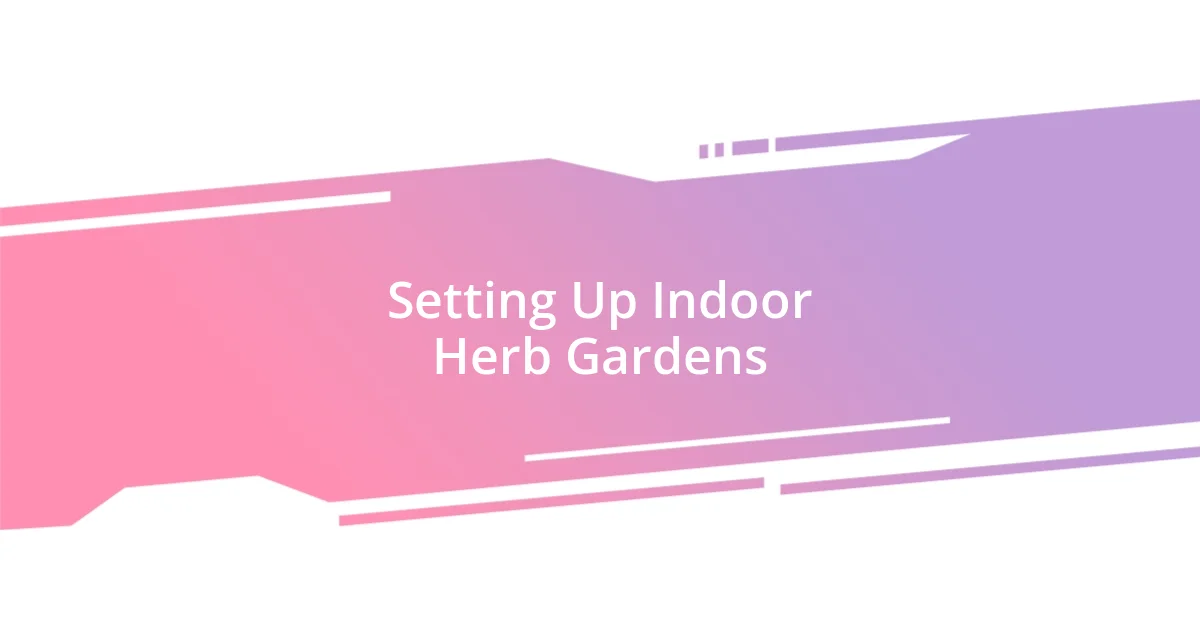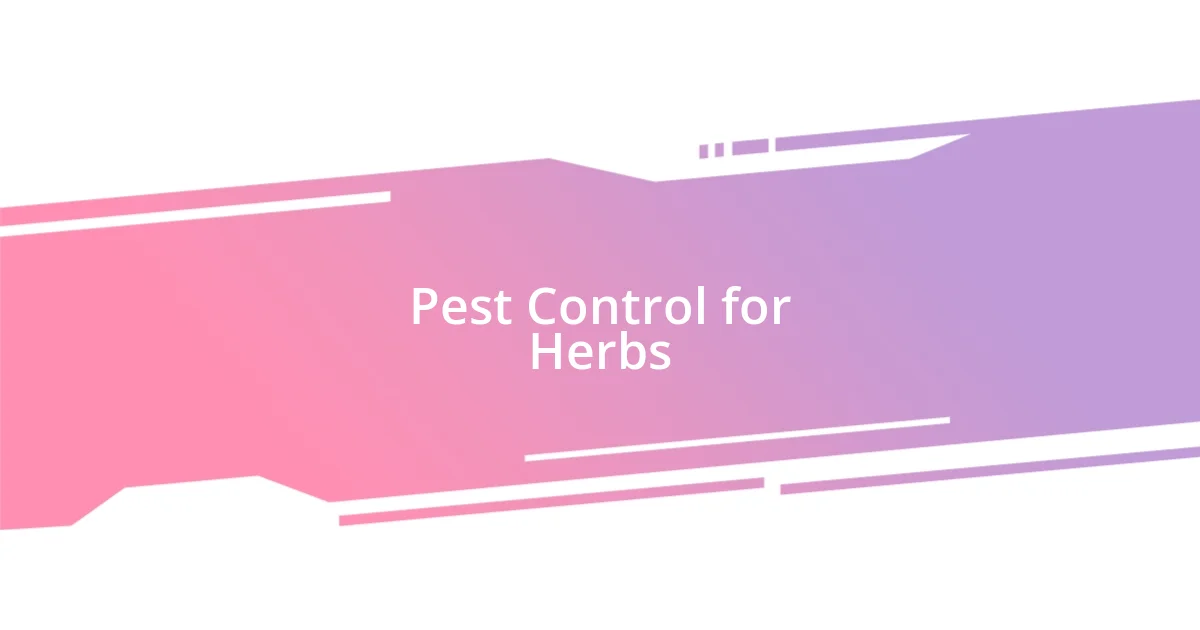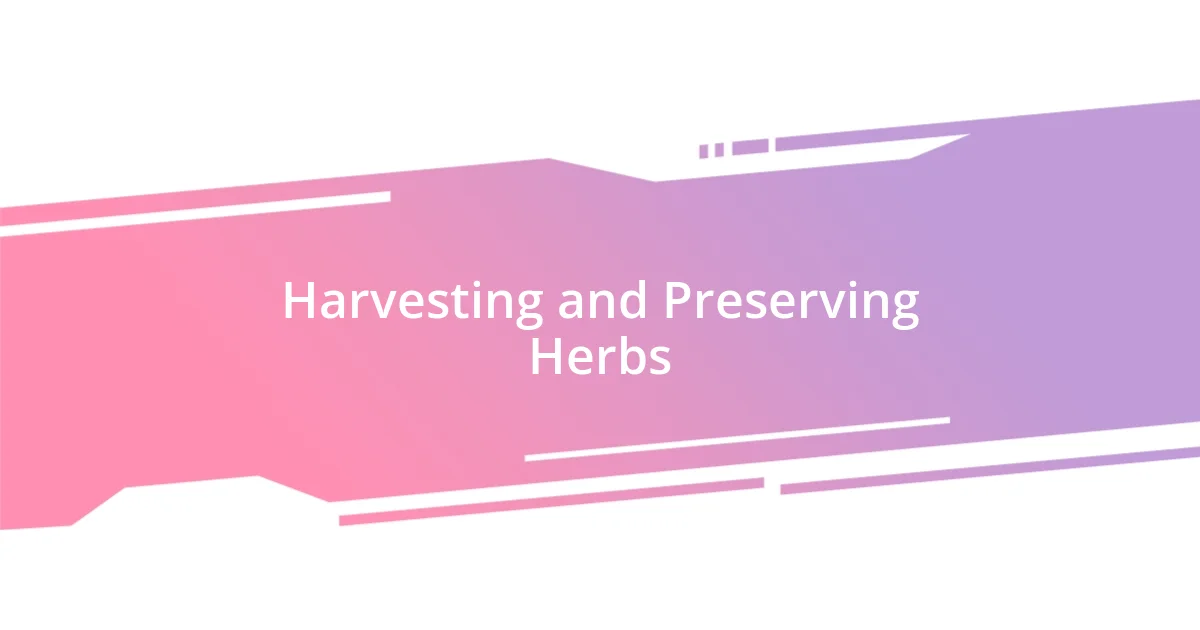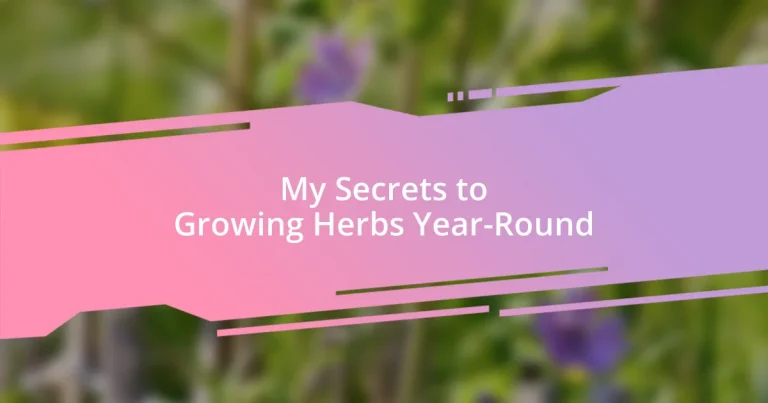Key takeaways:
- Understanding the specific growth needs of herbs, including temperature, humidity, and watering, is crucial for successful indoor gardening.
- Choosing the right herbs for your environment and utilizing appropriate containers and soil significantly enhances herb health and growth.
- Effective pest control strategies, along with proper harvesting and preservation techniques, can transform your herb gardening experience and extend the enjoyment of your harvest.

Understanding Herb Growth Needs
Understanding the growth needs of herbs is essential for any gardener looking to cultivate a thriving indoor garden. I remember my first time attempting to grow basil; it was a disaster until I learned that it thrives on warm temperatures and bright light. Understanding these specific needs—like the right amount of sunlight and consistent watering—can make all the difference.
Different herbs have distinct needs. For instance, did you know that some herbs, like rosemary, prefer drier soil conditions? I had a moment of panic when I overwatered my first rosemary plant, which led to root rot. Learning to read the signs of distress in plants helps create a bond; it’s almost like having a conversation with them.
Temperature and humidity play pivotal roles, too. In my experience, maintaining a humidity level around 40-60% has led to healthier growth. Sometimes, I wonder how many aspiring gardeners overlook these factors. It’s fascinating how a little attention to detail can transform your herb-growing journey.

Choosing the Right Herbs
Choosing the right herbs for your indoor garden can be both exciting and challenging. I vividly recall when I first decided to grow cilantro. I was so eager but didn’t realize it prefers cooler temperatures. Imagine my surprise when it started to wilt in my warm kitchen! It was a wake-up call that taught me not only to consider what I wanted to grow but also the specific requirements of each herb.
Here are some key herbs I recommend based on their growing needs:
- Basil: Loves warmth and bright light; ideal for sunny windowsills.
- Mint: Thrives in various conditions; just keep it in check as it can spread quickly.
- Parsley: Prefers cooler temperatures; can tolerate some shade.
- Chives: Enjoy moderate light; they’re forgiving and easy to grow.
- Thyme: Likes well-drained soil and is drought-resistant; an excellent choice for low-maintenance gardens.
Having these preferences in mind ensures that your herbs not only survive but thrive, which is incredibly rewarding. It’s amazing how connecting with their needs can deepen your gardening experience!

Setting Up Indoor Herb Gardens
Setting up an indoor herb garden can feel like a delightful mix of art and science. When I first ventured into this world, I quickly discovered that the right containers can significantly influence the health of my herbs. Choosing pots with drainage holes was a game changer for me; it allowed excess water to escape, preventing root rot. I still remember the joy of seeing my first basil flourish, simply because I provided it with the right environment.
Lighting is another crucial factor, and I learned this the hard way. Initially, I placed my herbs in a dim corner, thinking they’d be fine. Instead, they ended up weak and leggy. I now use grow lights to supplement natural sunlight, especially during the shorter winter days. It’s amazing how well herbs respond to the right lighting—watching them reach towards the light fills me with excitement every single time!
As for soil, I can’t stress enough how important it is to use a quality potting mix designed for herbs. I once tried to use garden soil and paid the price with poor growth and pests. Opting for a light, well-draining mix not only fosters healthy roots but also gives my plants a much better chance at thriving. I remember the first time I touched the enriched soil and felt the texture—it was like holding the key to nurturing life itself.
| Aspect | Recommendation |
|---|---|
| Containers | Use pots with drainage holes to prevent root rot. |
| Lighting | Supplement natural light with grow lights to ensure strong growth. |
| Soil | Opt for a quality potting mix designed for herbs. |

Best Soil and Containers
Selecting the best soil and containers is a critical step in my herb-growing journey. I learned this firsthand when I tried growing mint in a shallow container; it became root-bound faster than I expected. Now, I always choose deeper pots for herbs like mint, allowing ample room for growth and better moisture retention. Have you ever wondered why a simple change in container size can make such a difference? It’s because healthy roots lead to robust plants!
For soil, I’ve exclusively switched to using a high-quality potting mix designed specifically for herbs. Early on, I made the mistake of using generic garden soil, and my basil struggled like a fish out of water. Key ingredients in herb-specific mixes, like perlite for aeration and compost for nutrition, create a perfect environment that feels alive. The moment I started using this soil, I was astonished at the transformation—it was like my herbs suddenly discovered their superpowers!
Additionally, I’ve found that pots with drainage holes are indispensable. It sounds simple, but overlooking this detail can lead to disastrous results, as I learned during my first attempt at growing chives. After a series of overwatered mishaps, I made a commitment to always prioritize drainage. This realization not only saved my herbs but also added a layer of confidence in my gardening skills. Have you considered how crucial it is to understand the basics of your growing environment? Trust me, a little attention to these details makes all the difference in the world!

Light and Watering Requirements
When it comes to light, I’ve learned that my herbs are not just plants; they’re like little sun-seekers. I recall when I first grew cilantro. It sat perched on a windowsill where the sun barely touched. It struggled so much that I felt a pang of guilt—like I was holding back its potential. Now, I invest in grow lights, especially during those dreary winter months. They’ve transformed my indoor garden into a thriving haven, with my herbs standing tall and proud, soaking up every bit of artificial sunlight.
Watering can be tricky, and I found that underestimating its significance can lead to dramatic consequences. There was a time when I was overly enthusiastic and would water my herbs daily, thinking, “More is better!” However, I soon realized my beloved rosemary was wilting. The lesson was clear: I learned to check the soil moisture first. Now, I use the finger test—if my fingertip comes out dry after an inch of digging, it’s time for a drink. This simple technique not only saves my herbs from drowning but also deepened my connection with them.
I never cease to be amazed at how adaptable herbs can be. Take my sage, for example. It thrived in the bright light but became droopy when I forgot to water it during a busy week. I quickly learned that balancing light and water is crucial for a healthy, productive herb garden. Do you remember the last time a plant of yours seemed a bit off? Often, just a tweak in lighting or an adjustment in your watering routine can make it feel cherished again. In my experience, nurturing these little green companions is as much about observation as it is about action.

Pest Control for Herbs
Pests can quickly turn my herb garden from a thriving oasis to a battlefield. I remember the first time I noticed aphids on my basil; it felt like my heart sank—those little green bugs were ruining my hard work! After some research, I discovered that spraying a mixture of water and dish soap was an effective, organic way to tackle them. It felt like a little victory, reminding me that sometimes the best solutions are simple and right at our fingertips.
Another valuable lesson came when my mint was attacked by spider mites. I was puzzled at first, but examining the undersides of the leaves opened my eyes to a new level of care. I began using neem oil, a natural pesticide, and I was amazed at how effective it was while also being gentle on my plants. This experience taught me that being proactive is essential—regularly inspecting my herbs has become part of my routine. Have you ever taken a moment to really look closely at your plants? Trust me, those special dynamics can lead to better health and resilience in your herbs.
Companion planting has also become one of my secret weapons against pests. I’ve found that growing marigolds alongside my herbs not only looks beautiful but also attracts beneficial insects while repelling unwanted pests. It’s incredible how nature works in harmony when given the chance. Pairing my herbs with other plants feels like creating a balanced community, where each member plays a role. Have you thought about how your gardening choices can enhance the overall ecosystem of your plants? In my experience, fostering this kind of environment has significantly reduced the pest population and boosted the health of my crop.

Harvesting and Preserving Herbs
Harvest time is one of the most rewarding moments in herb gardening. I remember the first time I gently snipped fresh basil leaves, their sweet scent filling the air. It was like celebrating a little victory. Timing is crucial, though; I’ve learned to harvest in the morning, right after the dew has dried, ensuring the oils are at their peak. How do you know when to cut? For me, it’s simple: when the plant is lush and healthy, about one-third of the foliage can often be removed without stress, allowing the plant to continue growing.
Preserving herbs is where creativity truly shines. I’ve explored various methods, but drying them in a dark, cool place has been my go-to. Last summer, I made a huge batch of thyme and oregano. The aroma wafting through my kitchen while they dried brought nostalgia from my grandmother’s kitchen, where herbs were treasured for their flavor. It’s fascinating how drying not only extends their shelf life but also intensifies their flavors. When I now use these herbs in winter dishes, it feels like I’m bringing a taste of summer to the table.
Freezing is another effective way to keep herbs fresh. I remember my excitement when I discovered how to make herb ice cubes! Simply chop the herbs, mix them with a bit of olive oil, and pour the blend into ice cube trays. After they freeze, I pop them out and store them in bags. These little cubes have saved me countless times, bringing a burst of flavor to soups and sauces. Have you tried this method? It’s like having summer at your fingertips, all year round, which makes cooking feel like a celebration, even in the coldest months.














